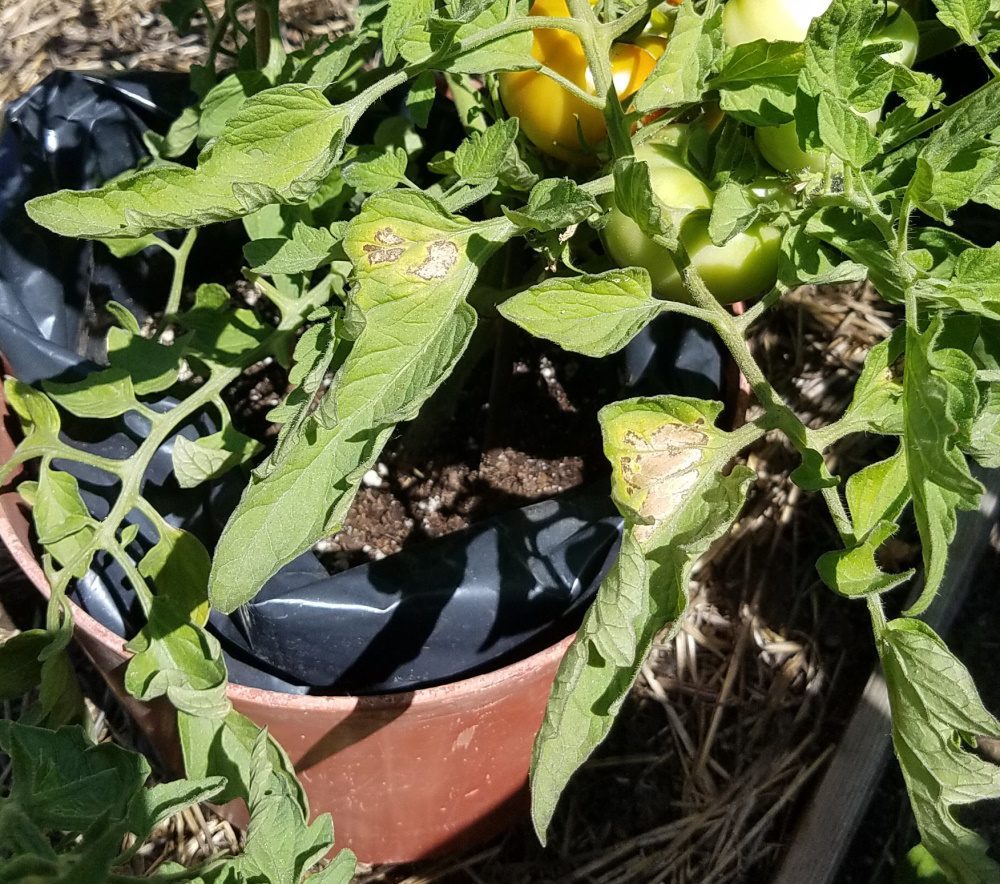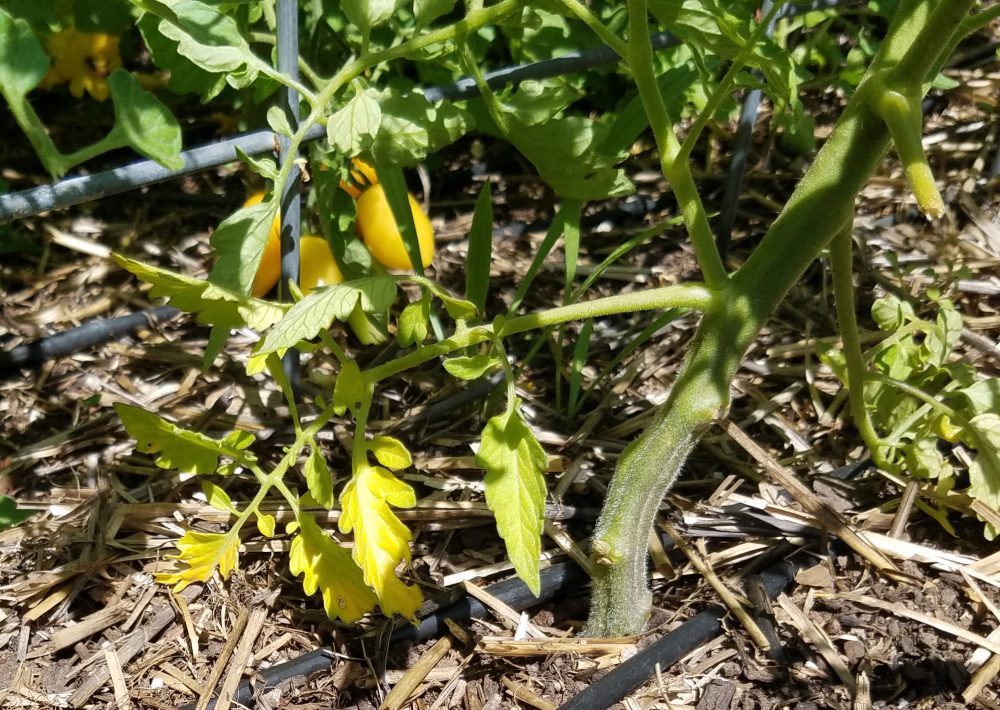Tomatoes are one of the most popular vegetables grown in the home garden, but they also happen to be highly susceptible to disease and pests.
The extent of disease impact can really depend on where you live in the country. Regions that tend to be cooler, dryer and less humid — like my region in North Idaho, generally see less disease than regions of the country that are hot and humid. Unfortunately, many tomato diseases are exasperated by hot, humid conditions that are common in coastal regions and the Southeast.
Diseases in the garden are common and eventually you will experience some type of disease. It just happens. It doesn’t mean that you have failed as a gardener – even the most seasoned and experienced gardeners face disease and pests – so don’t be discouraged when it occurs.
Diagnosing tomato disease can also be very challenging – even for experts. Many diseases exhibit similar conditions, such as leaf spotting or yellowing or browning leaves. It can be very difficult to determine if what you are seeing is Early Blight (Alternaria) or Septoria Leaf Spot.


My advice is if your once-healthy tomato plant, or any plant in your garden, starts to look poorly, take photos and collect samples of the affected leaf, stem, or fruit and get to your local County Extension or Master Gardener’s office. These professionals can help identify the problem and offer various methods for prevention and control. It’s a free resource and it can save you time and worry.
Disease Prevention
When it comes to tomatoes and diseases the saying “an ounce of prevention is worth a pound of cure” rings true.
Prevention really is the key. It’s far easier to prevent disease than it is to try and cure or eliminate it. In fact, many tomato diseases don’t have a “cure.” Meaning there isn’t a chemical application to “stop and reverse the disease” once it starts. Many diseases can be prevented by following basic gardening best practices (click to read).
One great option is to select plant varieties that are resistant to specific diseases and many hybrid tomato varieties are bred for just that. You may have seen plant tags with the letters “A,” “V,” or “F” on them. This designates that the plant is resistant to Alternaria (Early Blight), Verticillium Wilt and Fusarium wilt.
Disease resistant information can also been found in the plant descriptions of seed catalogs. But keep in mind – resistance to disease does not mean disease-proof. There aren’t any guarantees in gardening!
Early Blight (Alternaria)
The most common disease in tomatoes is the fungal disease, Early Blight, also known as Alternaria. Fungal spores can be soil-borne, meaning they live within the soil or they can float in on the wind from other affected plants. The disease can also be seed-borne, which is why it is very important to purchase seed from a reputable seed company.
Early blight starts out with small brownish-to-black spots on the oldest leaves of the plant, usually at the bottom and the spots eventually turn the leaves yellow. It will slowly make its way up the plant and in severe cases, it can in infect fruit.
Once the Early Blight hits there is no cure, but you can be proactive in removing the affected leaves and stems. Make sure to sanitize your tools before moving on to another plant – a quick spray of rubbing alcohol – will do the trick. And remember, diseased plant material goes in the trash, not the compost bin!
Early blight spreads easily and wantonly among tomatoes and others in the nightshade family – like peppers, eggplant and potatoes. Again, to help prevent this spread, follow plant spacing recommendations and practice crop rotation to avoid a buildup of spores in the soil.
Tomato Varieties Resistant to Early Blight: ‘Brandywine’, ‘Juliet’, ‘TommyToe’, ‘Matt’s Wild Cherry’




Septoria Leaf Spot
Septoria Leaf Spot, like Early Blight, is a fungal disease and affects the oldest and usually the lowest leaves on the plant first. Small spots or lesions on the leaves have dark edges with a lighter center and usually appear when the first fruit begin to set. As the disease grows, the lesions merge, turning the leaves yellow, then brown and and fall off the plant.
At the very center of the leaf spot you may see tiny black specs – these are the spore-producing bodies, which can be easily spread by water, wind, insects, your tools, and even your hands.
One way to tell the difference between Early Blight and Septoria is that Septoria affects only the plant’s leaves and stems, whereas Early Blight can affect the fruit. In the early stages of the disease it is difficult to determine which you are seeing – especially if fruit is not present.
Prevention methods are similar to Early Blight: water at the plant’s base, mulch around the plant, follow proper plant spacing and rotate crops yearly.
Tomato Varieties Resistant to Septoria Leaf Spot: There are currently not varieties that are resistant to this disease.


Powdery Mildew
Another very common fungal disease is Powdery Mildew. This disease occurs when conditions are humid or after heavy rains — or from overhead watering.
The fungus grows rapidly on wet foliage and it’s fairly common in the spring and fall – less so in the hot summer months. The disease is easily recognized by the dusty gray to yellowish blotches and the white fungal spores on the surface of leaves.
It fairly common in peas and cucumbers and spreads quickly between plants in an overcrowded garden.
Thankfully, powdery mildew isn’t a serious threat to tomatoes and can be prevented by watering only at the base of the plant, spacing plants properly at planting time, and pruning out tomato suckers to provide for good air circulation and to help dry wet leaves.
Tomato Varieties Resistant to Powdery Mildew: Most tomato varieties are susceptible to powdery mildew.


Late Blight
Late Blight is a fast-spreading and very damaging disease in tomatoes and potatoes. In fact, Late Blight was the cause of the Irish potato famine in the 1840s. The fungal-like pathogen is a water mold that favors cool, wet weather conditions and spreads quickly in wind and rain. Thankfully, extended periods of hot, dry days can stop the spread.
Dark, water-soaked spots can affect the plant’s leaves, stems, and fruit, followed by a white mold on the spot margins and on the underside of the leaves. Large, dark spots develop on affected fruit.
Late Blight strikes fast and the entire plant can turn brown, become defoliated, and wither within two weeks of infection.
To help prevent Late Blight select resistant varieties and practice crop rotation by not planting tomatoes where tomatoes, potatoes, peppers, or eggplants have been fore the past 3 to 4 years. Avoid overhead watering and keep leaves as dry as possible.
Tomato Varieties Resistant to Late Blight: ‘Mountain Magic’, ‘Mountain Merit’, ‘Legend’, ‘Black Plum’, ‘Jasper’, ‘Red Pearl’ and ‘Matt’s Wild Cherry’.

Photo: CornellCALS

Fusarium Wilt
Fusarium wilt is caused by a soil-borne fungus that’s common in warm, moist conditions. The pathogen enters plants through wounds in roots caused by cultivation or nematodes and works its way up the plant.
The lower leaves of plants droop and become yellow and eventually the entire plant turns yellow and wilts. Browning of leaves rarely occurs.
Plants begin to wilt as the fungi spreads throughout the xylem, blocking the flow of water and nutrients. This often starts on one side of the plant, but eventually the entire plant will succumb to the disease. If you cut the stem of a wilted plant lengthwise, you will see the xylem has turned dark brown and died.
Once Fusarium hits, completely remove all diseased plants and put them in the trash — not the compost pile. Avoid planting any tomatoes or nightshade plants in the same location for at least 3 to 5 years.
The best way to prevent Fusarium is to plant tomato varieties that are resistant to the disease. Look for the letter “F” on the plant tag or in the description. A few are listed below, but there are many more to choose from.
Tomato Varieties Resistant to Fusarium Wilt: Cherokee Purple’, ‘Roma’, ‘Roma VF’, ‘Rutgers’, ‘Sweet Million’, ‘Super Sweet 100’, ‘Sungold’, and many more.

Photo: University of Maryland Extension
Verticillium Wilt
Verticillium wilt is another soil-borne fungal disease that found in moist, cool soils. Like Fusarium Wilt, the disease enters plants through roots damaged by cultivation or nematodes.
The onset begins with yellow blotches on lower leaves — a common symptom of many tomato diseases. As the disease continues to work its way up the plant, brown veins and dead spots will appear in the leaves and the leaves will turn brown.
Initially, new growth on the top of the plant will stay green, but as the fungi spreads through the plant’s xylem, wilting will occur as water and nutrients are blocked. If you cut the base stem on a plant infected with Verticillium, you will see a brownish-black discoloration of the xylem. In addition, Verticillium carries a toxin that contributes to wilting and leaf spotting.
Also like Fusarium, Verticillium is long-lived in soil, so crop rotation is a must. Long crop rotations of at least 4 to 5 years without planting tomatoes or nightshades can help reduce the pathogen in the soil. Planting corn or cover crops during the off years helps to stave off Verticillium.
The best way to prevent Verticillium is to plant resistant tomato varieties. Look for a “V” and “N” (for resistance to nematodes) on the plant tag or description. A few are listed below, but thankfully, there are many more than those listed.
Tomato Varieties Resistant to Verticillium Wilt: ‘Cherokee Purple’, ‘Oregon Spring’, ‘Roma’, ‘Roma VF’, ‘Rutgers’, ‘Better Boy’, ‘Beefmaster’, ‘Big Girl’, ‘Super Sweet 100’, ‘Sungold’, and many more.

Photo: Texas A&M Extension
Again, it’s best to prevent disease instead of trying to cure it. Follow gardening best practices and consider adding disease-resistant tomato varieties to your garden.
Seeing insects infestations on your tomatoes? Check out this post on identifying insects on tomatoes.


[…] are a favorite garden vegetable to grow, but they tend to be highly susceptible to diseases and pests. When it comes to your tender, young tomato plants, it’s a bug’s life! There […]